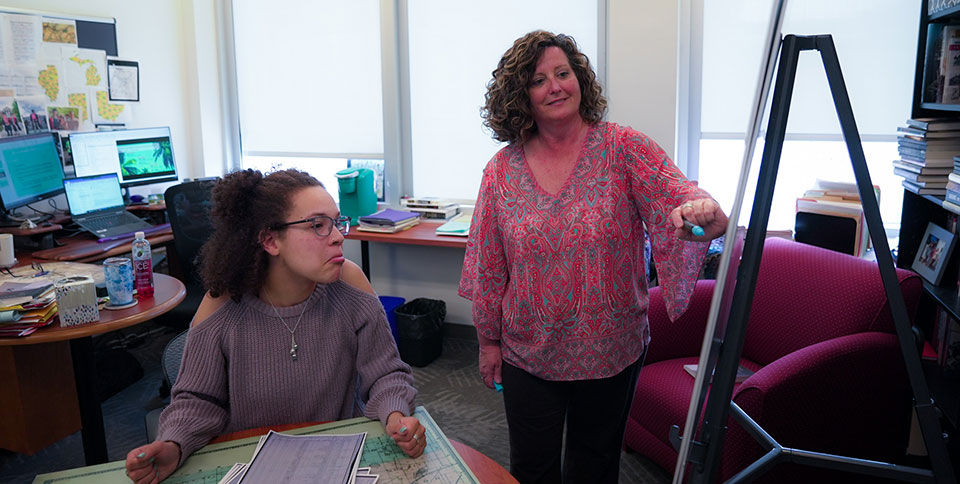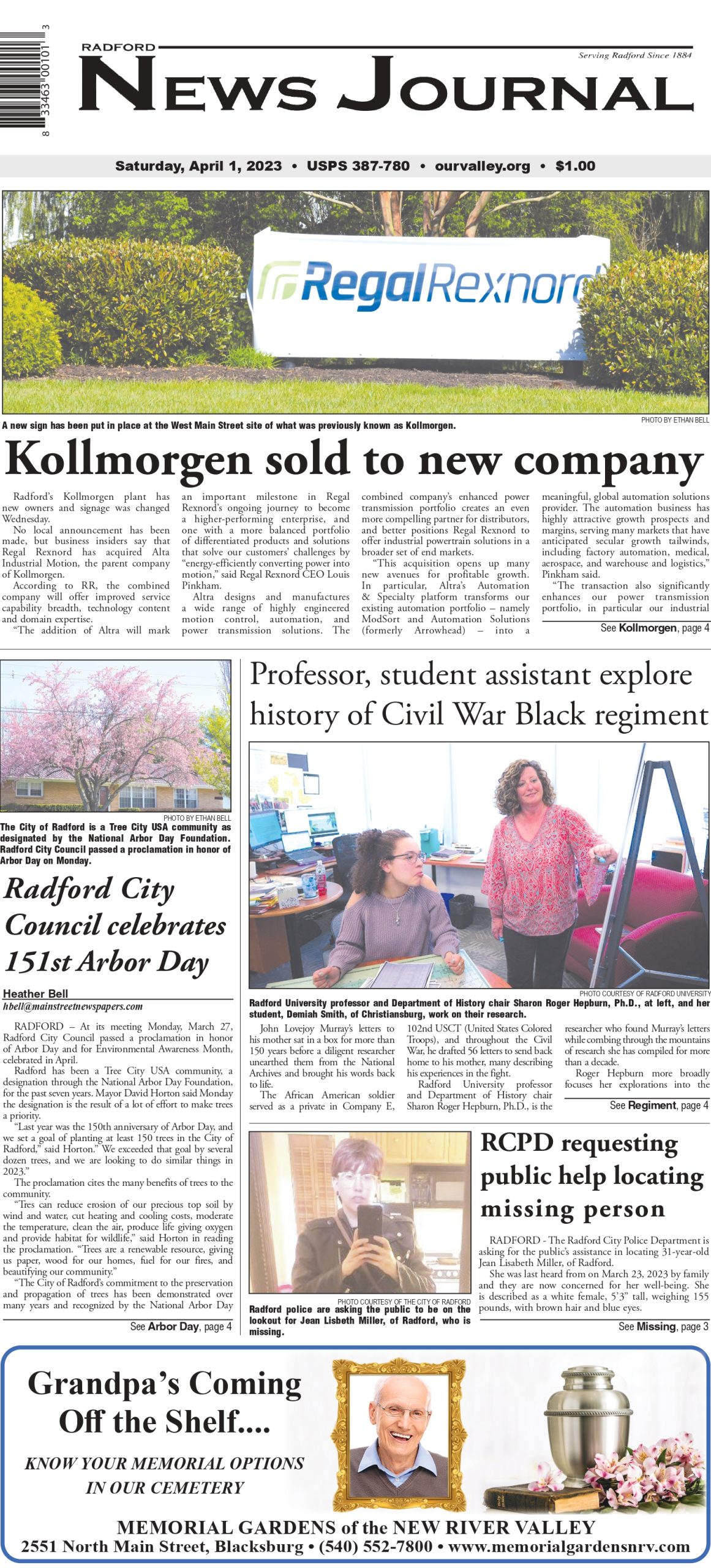
John Lovejoy Murray’s letters to his mother sat in a box for more than 150 years before a diligent researcher unearthed them from the National Archives and brought his words back to life.
The African American soldier served as a private in Company E, 102nd USCT (United States Colored Troops), and throughout the Civil War, he drafted 56 letters to send back home to his mother, many describing his experiences in the fight.
Radford University professor and Department of History chair Sharon Roger Hepburn, Ph.D., is the researcher who found Murray’s letters while combing through the mountains of research she has compiled for more than a decade.
Roger Hepburn more broadly focuses her explorations into the regimental history of the 102nd United State Colored Infantry and its Civil War service, but when she found Murray’s letters, it was a “wow moment,” the professor said. Those letters had been undisturbed in the soldier’s pension records folder since the 1870s.
“Whenever you put evidence in the pension system, it has to stay there,” explained Roger Hepburn, who in 2022 was recognized by the university as a Dalton Eminent Scholar for her teaching and research. “So, the letters were never returned to the soldier’s family.”
That inactivity proved to be valuable to the professor’s research, as well as other historians. “Otherwise, the letters would have been lost,” she said, “because he had no siblings, never married and had no children.”
Discovering the letters forced Roger Hepburn to slow her broader research to focus on Murray’s correspondence and records. That work led to her latest book, “Private No More: The Civil War Letters of John Lovejoy Murray, 102nd United States Colored Infantry (New Perspectives on the Civil War Era Service)”, published by University of Georgia Press and available March 15, 2023.
“The letters represent a perspective distinctly from a Black soldier in the Union army,” Roger Hepburn explained. “Although many of his experiences may have been typical, John Lovejoy Murray himself, a literate, freeborn, northern Black man, was atypical among Union Black soldiers.
Roger Hepburn began researching the 102nd United States Colored Infantry in 2011 as a regimental study, “but also a social study after the war,” she said.
The regiment mustered and trained in Michigan for seven months before they entered the field.
Through her work, Roger Hepburn has accumulated an extensive number of documents that includes enlistment papers, pension files, census records and letters written by and to the 1,642 soldiers in the 102nd regiment. Roger Hepburn found much of her collection in the National Archives, the Michigan state archives and local and county historical societies scattered around the United States.
Boxes of documents are stored in her office, and she has eight terabytes of information on a hard drive at home.
The research alone can be grueling but organizing it all for publication can be exhausting and overwhelming.
“I’m still transcribing documents from pension folders,” said Roger Hepburn, who teaches African American history, American slavery and the American Civil War at Radford. “Most of them are hundreds of pages, and the largest one is 885 pages.”
“It takes a long time,” she said, drawing out the word “long” for emphasis. “Plus, they are 150 years old, and the handwriting is atrocious.”
Luckily for the professor, she has students who share her interests. One in particular is Demiah Smith.
“I sucked her into it,” Roger Hepburn said with a laugh.
Smith enrolled in Roger Hepburn’s digital archives class in the fall of 2021, and “I totally fell in love with it,” said the senior history major from Christiansburg, Virginia. “She’s right; I did get sucked in.”
Her work included taking a “minuscule amount of the pension files,” Smith explained, and transcribing the contents. That work led to two projects of her own making. One involved creating a website that included records of four of the soldiers, while another involved constructing a detailed online map that followed the regiment through the duration of the war, from Detroit to Hilton Head to Savannah to Winnsboro, South Carolina.
“I love this,” Smith said. “I love uncovering history that no one knows about yet. Plus, it makes history more personal, and it makes lectures and textbooks come alive and seem more real. History is often thought of on a grandiose scale, and all of the everyday people who live through history are often forgotten.”
Smith fell head over heels in love with history in second grade while studying ancient Egypt, she explained, sitting in Roger Hepburn’s office in Hemphill Hall.
“It’s always ancient Egypt,” her professor chimed in, with a chuckle, about the topic that sparks many kids’ interest in history.
In about the fourth or fifth grade, Smith made the decision to pursue museums and archives as a college major and career. That decision, and the fact that her parents are Radford alumni, shined a light on her path to Radford University. “My mother (Sarah Smith ’00) was, of course, excited for me to become a Highlander,” Smith said while also explaining that her father, David Smith ’02, passed away in 2005.
“I’m sure he’d be excited for me to be at Radford,” she said.
“Coming to Radford has allowed me to feel closer to both my parents,” she continued, “and it’s the life they wanted to build for my brother and me.”
Similar family bonds helped Smith feel at home at Radford, particularly among the close-knit group of students and faculty in the Department of History. That feeling had a comforting influence on Smith’s decision for her future.
She soon learned Radford is an excellent place for research opportunities, like her work with Roger Hepburn, and diverse areas of study, like her minors in religious studies and applied history, which delves into such areas as digital archives and GIS mapping.
“I get to nerd out and do one of my favorite things all day, every day,” Smith said.
“Dr. Roger Hepburn was the one who planted the idea of doing my research project,” she continued. “Her faith in me meant the most because I had not been one to believe that research was a strong enough suit for me to take on such a challenge.”
Smith has taken challenges head-on during her nearly four years at Radford, including presenting her research twice in front of Radford President Bret Danilowicz, once at the university’s Board of Visitors meeting in September 2022 and another at Summer Undergraduate Research Fellowships (SURF) program that same year.
“The second time wasn’t nearly as bad because I was well versed,” she said, smiling.
Smith also guides other Radford students with their projects by serving as an Elevate Research Mentor. “That allows me to show others that anyone, regardless of the field or area of interest, is capable of doing a deeper level of research beyond Google searches.”
All this experience has led Smith to opportunities outside of campus as well. In the spring of 2022, she secured an internship at the Christiansburg Institute, which, thanks to the knowledge and skills she gained working with Roger Hepburn, led to a job at the institute as a scanning technician.
In addition to backing from faculty, Smith has found support in her academic pursuits through scholarships, including the Red and White Scholarship and the Highlander Scholarship.
“Those took the worry away from struggling to cover my education financially, and instead,” she said, “let me focus on reaping the benefits of using every avenue of my education.”
Smith is scheduled to graduate in May and plans to attend graduate school to pursue a master’s degree in library science with a concentration in archival studies.
Through their research, Smith and Roger Hepburn are making extraordinary contributions to their communities and the world around them. Occasionally, someone will hear about the professor’s work and contact her, asking for information about an ancestor. She generously sends any information she has available.
During one of Smith’s presentations, a military veteran approached and thanked her for the work she is doing, preserving the memories of those, like himself and John Lovejoy Murray, who served their country. “This was important to him,” Smith said, reflecting back. “I think the most rewarding part of this work is bringing the identities of these men and their families back to light.”
Chad Osborne for Radford University

